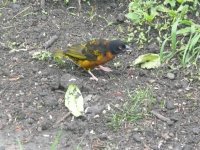janet.winter
New member
Hi. I happened upon this site while trying to identify a very odd visitor in my Northumberland garden. I haven't a clue what it is and haven't had any luck using identification sites. Anyone recognise it please? Its striking features are: beautiful yellow, burnt orange and black plummage; black head; heavy, finch like black beak; red eyes; strawberry pink legs. It is about the size of a starling.
Janet
Janet






